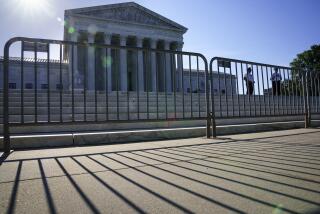He’s Too Extreme on Race, Women’s Rights, Speech . . .
- Share via
The confirmation of a chief justice of the United States is a more important responsibility for the Senate than our action on any other nomination to any other federal office. It is historical nonsense to suggest that all the Senate has to do is check the nominee’s IQ, be sure that he or she has a law degree and no arrests, and rubber-stamp the President’s choice.
The original blueprint for the Constitution gave the legislature sole authority for appointment of the judiciary. James Madison favored the selection of judges by the Senate. The provision adopted in the Constitution was a compromise described by Gouverneur Morris as giving the Senate the power “to appoint judges nominated to them by the President.” The intent is clear: The Senate has its own responsibility to scrutinize judicial nominees, and the highest scrutiny of all should be given to the person nominated to be chief justice.
It is no accident that the Constitution speaks not of the “Chief Justice of the Supreme Court,” but of the “Chief Justice of the United States.” As the language of the Constitution emphasizes, the chief justice symbolizes the rule of law in our society; he speaks for the aspirations and beliefs of America as a nation.
In this sense the chief justice is the ultimate trustee of American liberty; when Congresses and Presidents go wrong under the Constitution, it is the responsibility of the Supreme Court to set them right. And it is the chief justice’s responsibility to ensure that the court faithfully meets this awesome responsibility.
Presidents and Congresses come and go, but chief justices are for life. In the 200 years of our history there have been only 15 chief justices. The best of them, the greatest of them, have been those who applied the fundamental values of the Constitution fairly and generously to the changing spirit of their times.
Justice William H. Rehnquist does not measure up to those standards. As a member of the Supreme Court he has a virtually unblemished record of opposition to individual rights in cases involving minorities, women, children and the poor. U.S. Law Week’s Review of the past five terms of the Supreme Court indicates that he voted against the individual 77% of the time in cases involving individual rights. If unanimous decisions are excluded, where no plausible argument could be made against the individual he voted against the individual’s claim 90% of the time.
Rehnquist’s views are so far outside the mainstream even of the Burger court that in 54 cases decided on the merits he could not attract a single other justice to his extremist views.
Mainstream or too extreme? By his own record of isolated dissent, Rehnquist answers that question: He is too extreme on race, too extreme on women’s rights, too extreme on freedom of speech, too extreme on separation of church and state--too extreme to be chief justice.
His appalling record on race is sufficient by itself to deny his confirmation. When he came to the court, he had already authored a controversial memorandum supporting school segregation, he had opposed public-accommodations legislation, he had opposed remedies to end school segregation, and he had led a so-called ballot security program--a euphemism for intimidation of black and Latino voters. On many of these issues it now appears that he was less than candid at his confirmation hearings.
As a member of the Supreme Court, Rehnquist has been quick to seize on the slightest pretext to justify the denial of claims for racial justice. His dissent in the Bob Jones University case supported tax credits for segregated schools. In Batson vs. Kentucky his dissent supported the right of a prosecutor to prevent blacks and other minorities from serving on a jury.
America can be thankful that in the difficult and turbulent years since World War II we have had a Supreme Court that has been right on race, right on equal rights for women, right on apportionment and the separation of power, right on free speech and right on separation of church and state.
Imagine what America would be like if Rehnquist had been chief justice and his cramped, narrow view of the Constitution had prevailed in those critical years. The schools of America would still be segregated. Millions of citizens would be denied the right to vote under scandalous malapportionment laws. Women would be condemned to second-class status. Courthouses would be closed to individual challenges against police brutality and executive abuse--closed even to the press. The wall of separation between church and state would be in ruins. State and local majorities would tell us what we can read, whether to bear children, how to bring them up, what kinds of people we may become.
In these ways and in so many others, a court remade in the image of William Rehnquist would make the Constitution a lesser document in a lesser land.
Justice Rehnquist is outside the mainstream of American constitutional law and American values, and he does not deserve to be chief justice of the United States.
More to Read
Get the L.A. Times Politics newsletter
Deeply reported insights into legislation, politics and policy from Sacramento, Washington and beyond. In your inbox twice per week.
You may occasionally receive promotional content from the Los Angeles Times.










